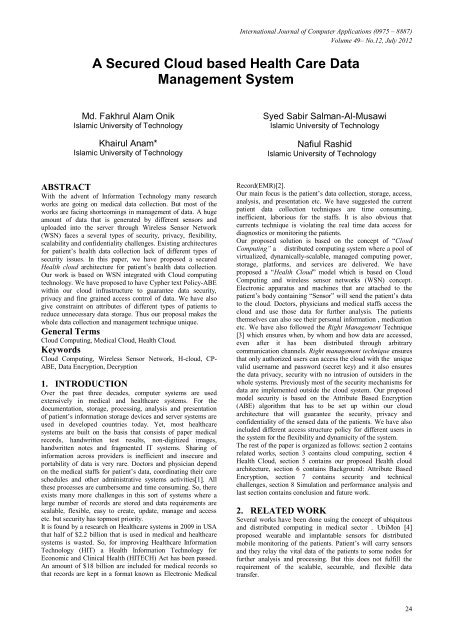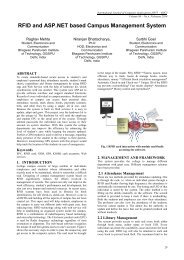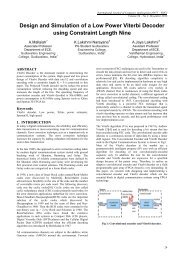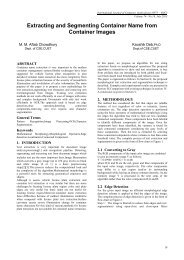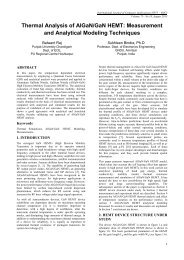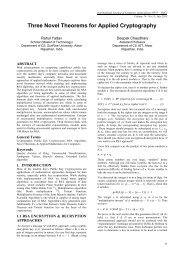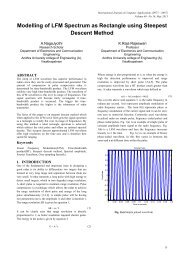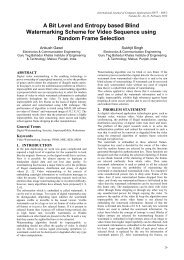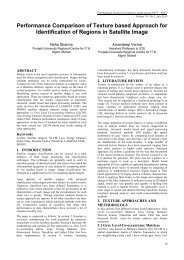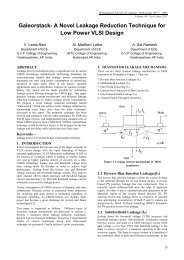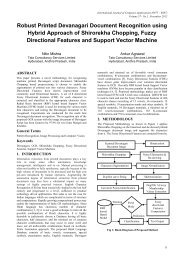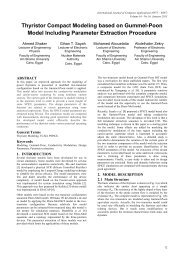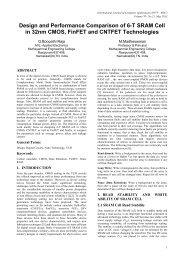A Secured Cloud based Health Care Data Management System
A Secured Cloud based Health Care Data Management System
A Secured Cloud based Health Care Data Management System
Create successful ePaper yourself
Turn your PDF publications into a flip-book with our unique Google optimized e-Paper software.
International Journal of Computer Applications (0975 – 8887)<br />
Volume 49– No.12, July 2012<br />
A <strong>Secured</strong> <strong>Cloud</strong> <strong>based</strong> <strong>Health</strong> <strong>Care</strong> <strong>Data</strong><br />
<strong>Management</strong> <strong>System</strong><br />
Md. Fakhrul Alam Onik<br />
Islamic University of Technology<br />
Khairul Anam*<br />
Islamic University of Technology<br />
ABSTRACT<br />
With the advent of Information Technology many research<br />
works are going on medical data collection. But most of the<br />
works are facing shortcomings in management of data. A huge<br />
amount of data that is generated by different sensors and<br />
uploaded into the server through Wireless Sensor Network<br />
(WSN) faces a several types of security, privacy, flexibility,<br />
scalability and confidentiality challenges. Existing architectures<br />
for patient‟s health data collection lack of different types of<br />
security issues. In this paper, we have proposed a secured<br />
<strong>Health</strong> cloud architecture for patient‟s health data collection.<br />
Our work is <strong>based</strong> on WSN integrated with <strong>Cloud</strong> computing<br />
technology. We have proposed to have Cypher text Policy-ABE<br />
within our cloud infrastructure to guarantee data security,<br />
privacy and fine grained access control of data. We have also<br />
give constraint on attributes of different types of patients to<br />
reduce unnecessary data storage. Thus our proposal makes the<br />
whole data collection and management technique unique.<br />
General Terms<br />
<strong>Cloud</strong> Computing, Medical <strong>Cloud</strong>, <strong>Health</strong> <strong>Cloud</strong>.<br />
Keywords<br />
<strong>Cloud</strong> Computing, Wireless Sensor Network, H-cloud, CP-<br />
ABE, <strong>Data</strong> Encryption, Decryption<br />
1. INTRODUCTION<br />
Over the past three decades, computer systems are used<br />
extensively in medical and healthcare systems. For the<br />
documentation, storage, processing, analysis and presentation<br />
of patient‟s information storage devices and server systems are<br />
used in developed countries today. Yet, most healthcare<br />
systems are built on the basis that consists of paper medical<br />
records, handwritten test results, non-digitized images,<br />
handwritten notes and fragmented IT systems. Sharing of<br />
information across providers is inefficient and insecure and<br />
portability of data is very rare. Doctors and physician depend<br />
on the medical staffs for patient‟s data, coordinating their care<br />
schedules and other administrative systems activities[1]. All<br />
these processes are cumbersome and time consuming. So, there<br />
exists many more challenges in this sort of systems where a<br />
large number of records are stored and data requirements are<br />
scalable, flexible, easy to create, update, manage and access<br />
etc. but security has topmost priority.<br />
It is found by a research on <strong>Health</strong>care systems in 2009 in USA<br />
that half of $2.2 billion that is used in medical and healthcare<br />
systems is wasted. So, for improving <strong>Health</strong>care Information<br />
Technology (HIT) a <strong>Health</strong> Information Technology for<br />
Economic and Clinical <strong>Health</strong> (HITECH) Act has been passed.<br />
An amount of $18 billion are included for medical records so<br />
that records are kept in a format known as Electronic Medical<br />
Syed Sabir Salman-Al-Musawi<br />
Islamic University of Technology<br />
Nafiul Rashid<br />
Islamic University of Technology<br />
Record(EMR)[2].<br />
Our main focus is the patient‟s data collection, storage, access,<br />
analysis, and presentation etc. We have suggested the current<br />
patient data collection techniques are time consuming,<br />
inefficient, laborious for the staffs. It is also obvious that<br />
currents technique is violating the real time data access for<br />
diagnostics or monitoring the patients.<br />
Our proposed solution is <strong>based</strong> on the concept of “<strong>Cloud</strong><br />
Computing” a distributed computing system where a pool of<br />
virtualized, dynamically-scalable, managed computing power,<br />
storage, platforms, and services are delivered. We have<br />
proposed a “<strong>Health</strong> <strong>Cloud</strong>” model which is <strong>based</strong> on <strong>Cloud</strong><br />
Computing and wireless sensor networks (WSN) concept.<br />
Electronic apparatus and machines that are attached to the<br />
patient‟s body containing “Sensor” will send the patient‟s data<br />
to the cloud. Doctors, physicians and medical staffs access the<br />
cloud and use those data for further analysis. The patients<br />
themselves can also see their personal information , medication<br />
etc. We have also followed the Right <strong>Management</strong> Technique<br />
[3] which ensures when, by whom and how data are accessed,<br />
even after it has been distributed through arbitrary<br />
communication channels. Right management technique ensures<br />
that only authorized users can access the cloud with the unique<br />
valid username and password (secret key) and it also ensures<br />
the data privacy, security with no intrusion of outsiders in the<br />
whole systems. Previously most of the security mechanisms for<br />
data are implemented outside the cloud system. Our proposed<br />
model security is <strong>based</strong> on the Attribute Based Encryption<br />
(ABE) algorithm that has to be set up within our cloud<br />
architecture that will guarantee the security, privacy and<br />
confidentiality of the sensed data of the patients. We have also<br />
included different access structure policy for different users in<br />
the system for the flexibility and dynamicity of the system.<br />
The rest of the paper is organized as follows: section 2 contains<br />
related works, section 3 contains cloud computing, section 4<br />
<strong>Health</strong> <strong>Cloud</strong>, section 5 contains our proposed <strong>Health</strong> cloud<br />
architecture, section 6 contains Background: Attribute Based<br />
Encryption, section 7 contains security and technical<br />
challenges, section 8 Simulation and performance analysis and<br />
last section contains conclusion and future work.<br />
2. RELATED WORK<br />
Several works have been done using the concept of ubiquitous<br />
and distributed computing in medical sector . UbiMon [4]<br />
proposed wearable and implantable sensors for distributed<br />
mobile monitoring of the patients. Patient‟s will carry sensors<br />
and they relay the vital data of the patients to some nodes for<br />
further analysis and processing. But this does not fulfill the<br />
requirement of the scalable, securable, and flexible data<br />
transfer.<br />
24
Telemedicine [5] an adaptive communication middleware for<br />
home monitoring for heart-patients is being developed. This<br />
helps remote monitoring and diagnosis of the patients. There<br />
are also some challenges in this kind of systems like-scalable,<br />
heterogeneity of the devices, protocols , database management,<br />
configuration of server, data security etc.<br />
Mobi<strong>Health</strong> project, Knostantas et al. [6] proposed an Body<br />
Area Sensor Network (BASN) prototype and tested that in nine<br />
preliminary cases in healthcare . For internal BAN<br />
communication they have used Bluetooth and Zigbee. And for<br />
communicating with external technologies they have used<br />
General Packet Radio Service (GPRS) and Universal Mobile<br />
Telecommunications <strong>System</strong> (UMTS). But after integration of<br />
the total system they did not get the expected result in the end.<br />
The exceptions were security, integrity and privacy of the data<br />
transmission.<br />
A group of researchers [7] have recently introduced a multitier<br />
telemedicine system that can perform real-time analysis on<br />
medical data and it also provides feedback to the users and<br />
uploads data to the server. It also suffers from the same<br />
problems with data integration, privacy and security.<br />
ESPAC [8] collects the data from the patients then at first it<br />
sends it to the hospital server and from there it is uploaded into<br />
the cloud. There is lack of flexibility and dynamicity of this<br />
kind of system. If the Hospital server fails to send the data or<br />
the server itself crash for some reasons then the whole data will<br />
not be sent. So, this kind of systems lack security and privacy<br />
of the data.<br />
Liang et al. [9] proposed a self-controllable access policy for<br />
the patients so that they can have easily access to their PHI<br />
(Personal <strong>Health</strong> Information). But this sometimes causes the<br />
whole system unsecured. Yu et al. [10] well defined access<br />
structure policy <strong>based</strong> on KP-ABE for managing and storing<br />
data in the cloud. Privacy and confidentiality of patient‟s<br />
information and use of secret key for accessing data from the<br />
cloud are guaranteed in this kind of system. Besides, many of<br />
research works have shown that use of fragmentation after<br />
encryption on data makes the data more reliable and improves<br />
the system‟s overall performance as potential intruders always<br />
try to compromise more data file to access.<br />
All of the above works they have implemented the security<br />
policy outside the cloud which is controlled by Administrator.<br />
In reality, this consumes more time for the user requested<br />
service and data sometimes becomes unreliable. For that<br />
purpose, we have proposed to have the security policy and<br />
access structure within the cloud so that the overall system<br />
performance regarding with security issues becomes more<br />
flexible. We have proposed to implement CP-ABE algorithm in<br />
our infrastructure to make the system more reliable.<br />
3. WHAT IS CLOUD COMPUTING<br />
There has been much discussion about what cloud computing<br />
actually means. The term cloud computing seems to originate<br />
from computer network diagrams that represent the internet as a<br />
cloud. Most of the IT companies and research teams such as<br />
IBM [11], Gartner [12] and Forrester research [13] have<br />
produced white papers to define the meaning of this term. The<br />
US National Institute of Standards and Technology (NIST) has<br />
developed a definition considering all aspects of it- “a model<br />
for enabling convenient, on-demand network access to a shared<br />
pool of configurable computing resources (e.g., networks,<br />
servers, storage, applications, and services) that can be rapidly<br />
provisioned and released with minimal management effort or<br />
service provider interaction [14] ”.<br />
International Journal of Computer Applications (0975 – 8887)<br />
Volume 49– No.12, July 2012<br />
<strong>Cloud</strong> computing is becoming one of the most expanding<br />
technologies in the computing industry today. It enables its‟<br />
users migrate their data and computation to the remote place<br />
with minimal impact of system performance [15]. It typically<br />
provides several benefits that cannot be realized otherwise. The<br />
benefits are-<br />
Scalable: <strong>Cloud</strong> computing provides as much computing power<br />
as any user wants. Though the underlying structure is not<br />
infinite it mitigates the developer‟s dependence on any specific<br />
hardware.<br />
Quality of Service (QoS): Unlike the other datacenter and<br />
distributed systems, <strong>Cloud</strong> provides much higher QoS than<br />
typically possible. This is due to the lack of the dependence on<br />
specific hardware. If one machine fails, other machines can<br />
provide the required QoS without hampering system<br />
performance.<br />
Specialized Environment: Users use custom interfaces, tools<br />
and services to meet their needs. This helps the users to use a<br />
new infrastructure with the latest legacy code.<br />
Cost Effective: Users pay as they get the requested service from<br />
the cloud providers, thus cloud is referred to as Payment as a<br />
Service (PaaS). This greatly reduces the risk for institutions<br />
which may be looking to build a scalable system.<br />
Simplified Interface - Whether using a specific application, a<br />
set of tools or Web services, <strong>Cloud</strong>s provide access to a<br />
potentially vast amount of computing resources in an easy and<br />
user-centric way. We have investigated such an interface within<br />
Grid systems through the use of the Cyberaide project [16, 17].<br />
3.1 Role of <strong>Cloud</strong> computing in Medical<br />
Sector<br />
In today‟s world most of the healthcare organizations need to<br />
modernize their IT infrastructure so that they can be able to<br />
provide safer, faster and more efficient healthcare delivery. But<br />
this requires a massive upgradation and development of their<br />
existing IT infrastructure. But constructing this kind of<br />
infrastructures involves huge amount of capital expenditure and<br />
sizeable operating and management expenses. But “<strong>Cloud</strong><br />
technology” mitigates that need to invest in IT infrastructure,<br />
by providing access to hardware, computing resources,<br />
applications, and services on a „per use‟ model. And thus it<br />
dramatically brings down the cost and eases the adoption of<br />
technology. Several EMR vendors and patrons are offering<br />
their cloud-<strong>based</strong> solutions and providing an alternative<br />
approach to help hospitals better manage the overall data<br />
management system which formerly needed massive capital IT<br />
investments to support EMR implementations.<br />
<strong>Health</strong> Information Exchanges (HIEs) are established in USA<br />
and other developed countries which are cloud-<strong>based</strong><br />
information repository where information can be more easily<br />
shared between hospitals, health systems, physicians, and<br />
clinics. Many technology vendors and service providers are<br />
emerging today who are already building cloud-<strong>based</strong> HIEs,<br />
many of which are already functioning very efficiently and<br />
providing awesome service to patients, administrative<br />
authorities, and providers. To improve their research many<br />
pharmaceutical companies are adopting cloud and drug<br />
development to discover newer, cheaper, and more effective<br />
treatment protocols and medicines. Hospitals and physicians<br />
have started to use cloud-<strong>based</strong> medical records and medical<br />
image archiving services. The objective is to mitigate the<br />
burdensome task from hospital IT departments and allow them<br />
to focus on supporting other imperatives such as EMR adoption<br />
and improved clinical support systems [18].<br />
25
4. HEALTH CLOUD (h-<strong>Cloud</strong>)<br />
<strong>Cloud</strong> computing actually offers multiple benefits for enterprise<br />
computing environments, similarly h-<strong>Cloud</strong> provides an<br />
infrastructure that allows hospitals, medical practices, insurance<br />
companies, and research facilities to improve their work<br />
capacity in a great extent and computing resources at lower<br />
initial capital outlays. Additionally, h-<strong>Cloud</strong> environments will<br />
lower the barriers for innovation and modernization of HIT<br />
systems and applications and make the overall health data<br />
management system more flexible and scalable.<br />
Besides, information contained within h-<strong>Cloud</strong> can also be<br />
better analyzed and tracked (with the proper information<br />
governance) so that health and treatments data, costs,<br />
performance, and effectiveness studies can be analyzed and<br />
acted upon accordingly. With the help of h-<strong>Cloud</strong>s, patient<br />
information can be shared easily and more securely among<br />
authorized physicians and hospitals. Thus it provides more<br />
timely access to life-saving information and reduces the need<br />
for duplicate testing. Besides, in early years cloud-<strong>based</strong><br />
solutions such as remote video conference physician visits is<br />
tested where physician checks patients through video<br />
conference remotely. Developing this kind of cloud <strong>based</strong><br />
healthcare solution for rural health and at the event of disasters<br />
is fruitful and praiseworthy. Besides, Hospitals and physicians<br />
are starting to see cloud-<strong>based</strong> medical records and medical<br />
image archiving services. Objective of this kind of solution is to<br />
reduce the burdensome task of the doctors, medical staffs etc.<br />
with improved medical systems.<br />
5. PROPOSED h-<strong>Cloud</strong> ARCHITECTURE<br />
“Figure 1” shows our proposed h-cloud architecture where<br />
Wireless Sensor Network (WSN) is integrated with cloud<br />
computing for storing patient‟s health data in the cloud . Our<br />
proposed architecture is scalable and able to store a large<br />
amount of data generated by sensors. As Patient‟s healthcare<br />
data are very sensitive we propose to have the security<br />
mechanism inside the cloud to guarantee data confidentiality,<br />
integrity, security, and fine grained access control. Previously<br />
security policies are implemented outside the cloud. Unlike<br />
existing patient healthcare DB management systems, security<br />
enforcement and key management in our solution are totally<br />
transparent to users (patients and doctors) and do not require<br />
their interventions.<br />
For our model, we have considered two categories of users,<br />
healthcare professionals (doctors, nurses, medical staffs) and<br />
patients, and is composed of the following modules:<br />
Security manager: It checks user authentication request for<br />
logging into the system through right management technique<br />
where license key (user name, password) is used. It also<br />
identifies which kind of access request is wanted- read or write<br />
using CP-ABE algorithm. Actually this is the main security part<br />
of our total system. We have proposed to implement CP-ABE<br />
algorithm here for the security of the data. In shortly, CP-ABE<br />
will generate private key and public key to encrypt set of<br />
attributes using access structure policy for the health data. The<br />
users (doctors, medical staffs and patients) use private key to<br />
decrypt and access the files.<br />
Service manager: It is responsible for taking user request and<br />
delivers the necessary services according to the request.<br />
<strong>Cloud</strong> <strong>Data</strong>base: It is actually the cloud storage of the data that<br />
are uploaded from the WSN. It contains all up-to-date health<br />
data of the patients that are transmitted to it periodically. <strong>Health</strong><br />
data contains patient‟s heart beat, blood pressure etc.<br />
International Journal of Computer Applications (0975 – 8887)<br />
Volume 49– No.12, July 2012<br />
Based on the operation our proposed scheme can be classified<br />
as follows:<br />
Step 1: Patient’s <strong>Health</strong> <strong>Data</strong> collection<br />
At the patient‟s side there is a sensor node which collects<br />
patient‟s health data (heart beat, blood pressure, motion and<br />
physiological) from the biomedical equipment that uses electric<br />
signal and transmits it to the secured WSN from where data is<br />
uploaded to the cloud using a fast and scalable Sensor <strong>Data</strong><br />
Dissemination mechanism [19] [20].<br />
Step 2: <strong>Data</strong> Encryption<br />
In this step, CP-ABE algorithm is used to encrypt data. For<br />
encryption at first CP-ABE generates a public key and a master<br />
key. After that <strong>based</strong> on the attributes of the users on the system<br />
cpabe-keygen generates a private key for a set of attributes.<br />
Then cpabe-enc is used to generate a public key and encrypt<br />
the data <strong>based</strong> on the access structure policy.<br />
Step 3: Access to the cloud and Decryption of <strong>Data</strong><br />
To access data from the cloud the users should authenticate<br />
and granted access permission. Using right management<br />
technique this authentication is ensured. From the users<br />
(doctors, nurses, medical staffs) side user logs onto the system<br />
from their handheld devices or PCs through the WEB 2.0<br />
application using his unique name and password (secret key).<br />
User then can decrypt data (cyphertext) if and only<br />
corresponding access policy structure supports him and he has<br />
the private key of the attributes . We have also proposed an<br />
image-<strong>based</strong> authentication and activity-<strong>based</strong> access control to<br />
enhance security and flexibility of user‟s access [21].<br />
To achieve fine-grained access control, we have proposed to<br />
use Attribute Based Encryption (ABE) technique to encrypt<br />
data before storing them on the cloud. Establishing ABE in<br />
medical cloud computing is a real challenge. <strong>Data</strong> are<br />
represented by logical expression and encrypted with an access<br />
structure in ABE. If the user has the secret key that satisfies<br />
access policy then they can easily decrypt those encrypted data.<br />
Though ABE consumes much more processing power than<br />
symmetric cryptography it is very useful for data encryption.<br />
Besides, another advantage of using ABE is that authorization<br />
information can be embedded in the encrypted data so<br />
unauthorized users cannot have access to the data without<br />
secret key. But the situation becomes cumbersome when the<br />
data changes access policy [22]. So,when the data changes it‟s<br />
access policy the corresponding data is re-encrypted with the<br />
new changed access structure and upload it to the cloud.<br />
Another challenge is that who will construct the access<br />
structure and given policy and also the secret keys to access<br />
those data from the cloud.<br />
Fig 1 : Proposed H-<strong>Cloud</strong> Architecture.<br />
26
For solving the first challenge we have proposed to use both<br />
randomly generated symmetric key (RSK) and ABE to encrypt<br />
data. So, all files are encrypted using a randomly generated<br />
symmetric key (RSK) and encrypt the RSK by ABE. Then the<br />
encrypted files are uploaded to the cloud DB for user<br />
authorized users. Each authorized user has a secret key, if it<br />
satisfies the access structure policy then the user can easily<br />
decrypt the RSK and hence decrypt the file. If the data changes<br />
it‟s access policy the corresponding data is re-encrypted with<br />
the new changed access structure using RSK and upload it to<br />
the cloud. Thus the overhead sing ABE is reduced here.<br />
To solve the second challenge we have proposed a new module<br />
Security Manager which specifies and enforces the security<br />
policies of the healthcare institution. It is used by the<br />
administrators of the healthcare institutions to define rules as<br />
“who can access to what” but it is embedded within cloud.<br />
Based on these administrator specified rules, security manager<br />
generates ABE security parameters access structure and secret<br />
key.<br />
The secret key is used for the user privileges on a specific file<br />
in the cloud. Since the users have to decrypt data secret key is<br />
used for this purpose. Access structure refers to the access<br />
policy of the users on the file. Not all users in the system are<br />
given the same privileges on all files. For example, only<br />
doctors has both the write and read access policy on the<br />
patient records while the nurses have only the read access.<br />
Thus our proposed system will ensure to improve system<br />
usability since a patient has no action to do to secure his data.<br />
Several advantages related to our proposal are-<br />
It removes the time consuming burdensome task of<br />
collecting patient‟s data manually and possibility of typing<br />
errors<br />
Patient‟s health data is uploaded in the real time so<br />
always up-to-date information is found.<br />
It ensures the data security and privacy.<br />
It also provides the way of distant medical healthcare.<br />
As Security Manager is within the cloud so if we<br />
implement our CP-ABE security policy within our cloud so<br />
there will be some more time can be saved in key generation,<br />
encryption and decryption.<br />
We are defining some fixed attributes for each type of<br />
different patients so that unnecessary information about patients<br />
cannot be saved in the cloud database. Thus we are proposing<br />
to have more flexibility in data management system.<br />
5.1 Policy Enforcement on Access<br />
Permission<br />
The security policy of each fragment of data is embedded<br />
within the respective fragment using a sticky policy method<br />
[23]. This policy is cryptographically developed within the<br />
fragment so that other policy will not work within the fragment.<br />
Read access of the data fragment is maintained and protected<br />
by symmetrically encrypt every single data fragment with a<br />
symmetric key. This symmetric fragment key is in turn<br />
encrypted with the license key of the user. When any user<br />
makes a request it is matched with the user‟s license key for<br />
decrypting the fragment key corresponding rights in the policy.<br />
Write access to a data fragment is maintained by cloud DB. The<br />
cloud DB checks users access policy for any fragment that is to<br />
be written and granted write privileges (update and delete) to<br />
that.<br />
International Journal of Computer Applications (0975 – 8887)<br />
Volume 49– No.12, July 2012<br />
6. BASICS OF CIPHER TEXT POLICY<br />
ATTRIBUTE BASED ENCRYPTION(CP-<br />
ABE)<br />
Attribute-<strong>based</strong> encryption (ABE) [24], one of most preferable<br />
identity-<strong>based</strong> cryptographic systems where attributes are taken<br />
as input and cryptographic operations are done on those<br />
attributes <strong>based</strong> on defined policies. In shortly, In Attribute-<br />
Based Encryption a user‟s identity is composed of a set, S, of<br />
strings which serve as descriptive attributes of the user. For our<br />
case the patient‟s attributes are contact information, disease,<br />
medicines, medical tests etc. There is an another set of<br />
attributes S1 that helps a use to decrypt a message if his identity<br />
S has at least k attributes matched with the set S1, where k is a<br />
parameter set by the administrator of the system. The Attribute-<br />
Based Encryption system only needs to know the description of<br />
the user for determining his secret key.<br />
The ABE consists of four algorithms:<br />
Setup (k): This algorithm takes security parameter and attribute<br />
value as input, k and outputs a master key MK to generate<br />
secret keys in the Key generation algorithms and a set of public<br />
parameters PK .<br />
Key-Gen (S,MK): The authority executes the Key-Gen<br />
algorithm for generating a new secret key SK. The algorithm<br />
takes as input a set of user‟s attributes, S, and the master-key<br />
MK and outputs a secret key SK corresponding to S.<br />
Encryption (M,S1,PK): This Encryption algorithm takes input a<br />
message M, with a set of attributes S1 (access structures) , and<br />
the public parameters PK. It outputs a ciphertext, CT.<br />
Decryption (CT, S1, S, SK): The Decryption algorithm is run by<br />
a user with identity S and secret key SK to decrypt a ciphertext<br />
C that has been encrypted with S1. With the help of identity<br />
attributes S and secret key SK, this decryption algorithm is used<br />
to decrypt a ciphertext CT that has been encrypted by S. If the<br />
set |S union S1| is greater than or equal to k this algorithm<br />
shows the decrypted message M.<br />
7. SECURITY AND TECHNICAL<br />
CHALLENGES<br />
We describe some of the core challenges [25] in designing<br />
wireless sensor networks <strong>based</strong> cloud computing for healthcare<br />
applications.<br />
7.1 User Authentication <strong>Management</strong><br />
Users can easily access their personal information y through<br />
cloud services and make it available to various services across<br />
the Internet. An identity management (IDM) mechanism can<br />
help authenticate users in the cloud and to do log onto the cloud<br />
system. Existing authentication mechanism <strong>based</strong> on password<br />
has some inherent limitation and poses significant risks. For<br />
this reason, IDM system should always be able to protect<br />
private and confidential information of the users and processes.<br />
While users interact with a service provided by the cloud, this<br />
service might need to guarantee that their identity is protected<br />
from other services with which it interacts. Besides, cloud<br />
providers must differentiate customer identity and<br />
authentication information from other shared services in the<br />
cloud environments.<br />
7.2 Privacy and Protection of <strong>Data</strong><br />
Privacy of the data in the cloud computing environment is one<br />
of the top most priority challenges. As cloud provides their<br />
users as a shared infrastructure so user‟s personal information<br />
are often susceptible unauthorized access and exposure. So,<br />
cloud service providers must assure high degree of privacy-<br />
27
protection mechanisms to guarantee user submitted personal<br />
information as well as the stored data in the cloud. As sensed<br />
data are sent using Wireless Sensor Network (WSN) so<br />
information such as- who created the data, who has the access<br />
priority of using these data, what kind of access policy does one<br />
have, who modified it and so on are important and they should<br />
be kept with maximum level of security protection so that<br />
intruders cannot access it.<br />
7.3 SLA and QoS<br />
SLA refers to the part of the service contract where the level of<br />
service is defined. The service integrator provides the platform<br />
for each individual service provider that helps them to<br />
guarantee the QoS as well as SLA. Many cloud service<br />
providers use traditional Web Services Description Languages<br />
(WSDL) to describe the services such as- bandwidth, delay<br />
time, power efficiency etc. Besides, automatic infrastructures<br />
that uses different types of wireless devices often lack of QoS<br />
and SLAs.<br />
7.4 Access Policy Collaboration<br />
As cloud environment consists of heterogeneous server and<br />
each server may have different types of access policy structures<br />
and security approaches so synchronization among these<br />
should be ensured for the overall performance of the cloud. But<br />
for synchronization purpose the QoS and security approaches<br />
are sometimes hampered. So, cloud providers should manage<br />
and collaborate the access policy among the servers in a way so<br />
that no security breaches are occurred.<br />
Fig 2: Example of the usage of Cpabe toolkit.<br />
8. SIMULATION AND PERFORMANCE<br />
ANALYSIS<br />
For the simulation purpose we have used cpabe toolkit [26]. It<br />
is an open source package for cryptography used in LINUX<br />
environment. It is composed of four algorithms that we have<br />
described earlier. We have done our simulation in Red Hat<br />
Linux 5.0 using VMware 7.0. All the experiments are carried<br />
out in VM ware which provides default 1.66 GHz singleprocessor<br />
with 1 GB RAM. As our proposed architecture and<br />
International Journal of Computer Applications (0975 – 8887)<br />
Volume 49– No.12, July 2012<br />
implementation of the ABE algorithm in our system will<br />
provide the maximum security and confidentiality of the data,<br />
for this we have simulated the ABE algorithm many times with<br />
data having different number and types of attributes to clarify<br />
the result.<br />
“Figure 2” provides a sample usage of ABE in our simulation.<br />
Cpabe-keygen command generates a private key for the set of<br />
attributes- cardiac_profile, medicinal _profile and surgical_<br />
profile for a doctor. We have changed the attributes number<br />
different times and tested each time. Cpabe-enc tool is then<br />
used for encryption of data. It generates a public key which<br />
encrypts a file under a defined access structure policy. This<br />
policy allows doctors and other medical staffs to decrypt the<br />
file. Cpabe-dec tool allows the users to use a private key to<br />
access the encrypted files. As each user has different access<br />
structure policy for accessing data from the cloud our proposed<br />
module “security Manager” automatically defines the access<br />
policy for the user identifying user category. Thus our system<br />
provides fine grained access structure and which enhances our<br />
overall system security.<br />
8.1 Performance Measurement<br />
We have provided some simulation results that we have found<br />
using cpabe toolkit. We have calculated total time for<br />
generating key, encryption and decryption. “Figure 3” shows<br />
our simulation result <strong>based</strong> on private key generation time,<br />
encryption time and decryption time. We have found the time<br />
running cpabe-keygen, cpabe-enc and cpabe-dec by using<br />
different number of attributes thus changing access tree size.<br />
(a) Key generation time<br />
(b) Encryption tim<br />
28
(c) Decryption time<br />
Fig 3: Performance analysis using Cpabe toolkit.<br />
cpabe-keygen should have run linearly with the increasing<br />
number of attributes. As we have tested key generation time<br />
with less attributes so it is found at first it becomes curve<br />
(actually graph with many attributes does not show any curve)<br />
and then increases linearly with number of attributes. Our<br />
assumption is that patients do not have more than a predefined<br />
number of attributes according to his/her disease types. We<br />
have assumed it for the flexibility of the data. Similarly, with<br />
the increasing number of leaf nodes in policy the running time<br />
of cpabe-enc at first increase linearly and then creating a curve<br />
shape it again becomes linear with time. But for measuring the<br />
running time of cpabe-dec we have faced difficulties as it<br />
depends on the access tree and number of attributes. For the<br />
variation on the decryption time, we ran cpabe-dec two times<br />
on a series of randomly generated attributes and found the<br />
curve that is in “Figure 3(c)”.<br />
From the figure it is easy to see that decryption time randomly<br />
increases with the amount of leaf nodes in the access policy.<br />
Our simulation should be optimal as we are implementing CP-<br />
ABE within the cloud in Security Manager. Previously it is<br />
implemented on <strong>Health</strong>care Administration or others<br />
administrative parts of the system which is actually supervised<br />
by human experts. But our proposed solution will have it in<br />
cloud architecture so that the overall time for key generation,<br />
encryption and decryption should be less compared to the other<br />
implementation. Besides, it also reduces the overhead to<br />
generate private keys for unwanted attributes of the patient as<br />
we have proposed to define a fixed number of attributes for the<br />
flexibility of the system. Thus our proposed solution will<br />
provide topmost security and confidentiality of the patient‟s<br />
health data.<br />
9. CONCLUSION<br />
In this paper, we have demonstrated the challenges of storing<br />
data using cloud computing technology. Accordingly, we have<br />
proposed a <strong>Health</strong> <strong>Cloud</strong> architecture for secured data<br />
management of the patients. To implement a fine grained<br />
privacy and security policy, We have proposed to implement<br />
Cipher text-Policy Attribute Based Encryption (CP-ABE)<br />
International Journal of Computer Applications (0975 – 8887)<br />
Volume 49– No.12, July 2012<br />
algorithm within our proposed Security Manager module in our<br />
system. Our system allows the users to have a fine grained<br />
access control using private keys to decrypt the encrypted files.<br />
Through performance evaluation we have measured the time<br />
needed for key generation, encryption and decryption. We are<br />
claiming that if we implement the CP-ABE algorithm in the<br />
cloud then there will be less performance overhead for the<br />
security and confidentiality of the data. Because it does not<br />
need to check whether a user in the cloud is doctor or other<br />
medical staff or patient. As at the time of authorization in the<br />
cloud, the user always defines his/her category or type in the<br />
system. So, there is no need for an administrative person to do<br />
the same and we have proposed to have an automotive system.<br />
It would be more efficient if we can implement the whole<br />
“<strong>Health</strong> <strong>Cloud</strong>” architecture and find out the limitations. In our<br />
upcoming research, we are planning to implement the whole<br />
system and to go through more to performance evaluation of<br />
key generation time, encryption time and decryption time.<br />
10. REFERENCES<br />
[1]http://www.cloudbook.net/downloads/index.php?file=cloudb<br />
ook-magazine-aug- 2010.pdf<br />
[2] http://www.dynamicglobalstaffing.com/news<br />
[3] Milan Petkovi´c, “Rights <strong>Management</strong> Technologies: A<br />
Good Choice for Securing Electronic <strong>Health</strong> Records?”. In<br />
ISSE/SECURE 2007: securing electronic business<br />
processes: highlights of the Information Security Solutions<br />
Europe/SECURE 2007 Conference, page 178. Springer,<br />
2007<br />
[4] Ng, J., Lo, B., Wells, O., and Sloman, M. (2004).<br />
Ubiquitous Monitoring Environment for Wearable and<br />
Implantable Sensors (UbiMon). In Proceedings of the<br />
International Conference on Ubiquitous Computing<br />
(Ubicomp).<br />
[5] Singh, G., O‟Donoghue, J., and Soon, C. K. (2002),<br />
“Telemedicine: Issues and Implications”. Technology<br />
<strong>Health</strong> <strong>Care</strong>,10(1):1–10<br />
[6] D. Konstantas et al., “Mobile Patient Monitoring: The<br />
Mobi<strong>Health</strong> <strong>System</strong>”. Proc. Int‟l. Cong. Med. and <strong>Care</strong><br />
Compunetics, Hague, The Netherlands, 2–4 June 2004<br />
[7] E. Jovanov et al., “A Wireless Body Area Network of<br />
Intelligent Motion Sensors for Computer Assisted<br />
Physical Rehabilitation”. J. NeuroEng. and Rehab., vol. 2,<br />
no. 11, Mar. 2005, p. 6.<br />
[8] Mrinmoy Barua*, Xiaohui Liang, Rongxing Lu and<br />
Xuemin Shen. “ESPAC: Enabling Security and Patientcentric<br />
Access Control for e<strong>Health</strong> in cloud Computing”,<br />
International Journal of Security and Networks, 2011<br />
[9] X. Liang, R. Lu, X. Lin, and X. Shen. “Patient selfcontrollable<br />
access policy on phi in healthcare systems”,<br />
AHIC 2010, Kitchener, Ontario, Canada, pp.1–5<br />
[10] S. Yu, C. Wang, K. Ren and W. Lou, (2010), “Achieving<br />
secure, scalable, And fine-grained data access control in<br />
cloud computing”, INFOCOM, 2010 Proceedings IEEE,<br />
San Diego, CA, USA, pp.1–9.<br />
[11] IBM, Staying aloft in tough times, 2009<br />
[12] C.D. Plummer, T.J. Bittman, T. Austin, D.W. Cearley and<br />
D.M. Smith. <strong>Cloud</strong> Computing: Defining and Describing<br />
an Emerging. Phenomenon, 2008<br />
29
[13] Staten, J., Is <strong>Cloud</strong> Computing Ready For The Enterprise?<br />
2008.<br />
[14] Mell, P. and GRANCE, T. 2009. Draft NIST Working<br />
Definition of <strong>Cloud</strong> Computing.<br />
[15] L. Wang, G. von Laszewski, A. Younge, X. He, M.<br />
Kunze, and J. Tao. <strong>Cloud</strong> computing: a perspective study.<br />
New Generation Computing, to appear in 2010.<br />
[16] G. von Laszewski, A. Younge, X. He, K. Mahinthakumar,<br />
and L. Wang. “Experiment and Workflow <strong>Management</strong><br />
Using Cyberaide Shell”, 4th International Workshop on<br />
Workflow <strong>System</strong>s in e-Science (WSES 09) in<br />
conjunction with 9th IEEE International Symposium on<br />
Cluster Computing and the Grid. IEEE, 2009<br />
[17] G. von Laszewski, F. Wang, A. Younge, X. He, Z. Guo,<br />
and M. Pierce, “Cyberaide JavaScript: A JavaScript<br />
Commodity GridKit”. GCE08 at SC‟08. Austin, TX:<br />
IEEE, Nov. 16 2008.<br />
[18] http://csrc.nist.gov/ publications/drafts/800-145/Draft-SP-<br />
800-145_cloud-definition.pdf<br />
[19] L. Vinh, X.H. Le, S. Lee. “Semi Markov Conditional<br />
Random Fields for Accelerometer Based Activity<br />
Recognition (submitted)”.<br />
[20] M. Hassan, E. Huh, “ A Framework of Sensor-<strong>Cloud</strong><br />
Integration:Opportunities and Challenges”. International<br />
International Journal of Computer Applications (0975 – 8887)<br />
Volume 49– No.12, July 2012<br />
Conference on Ubiquitous , Information <strong>Management</strong> and<br />
Communication.<br />
[21] H. Jameel, R.A. Shaikh, H. Lee and S. Lee. Human<br />
Identification through Image Evaluation Using Secret<br />
Predicates. Topics in Cryptology - CT-RSA 07, LNCS<br />
4377 (2007) 67–84.<br />
[22] Ahmed Lounis, Abdelkrim Hadjidj, Abdelmadjid<br />
Bouabdallah and Yacine Challal “Secure and Scalable<br />
<strong>Cloud</strong>-<strong>based</strong> Architecture for e-<strong>Health</strong> Wireless sensor<br />
networks”<br />
[23] M.C. Mont, S. Pearson, and P. Bramhall. Towards<br />
accountable management of identity and privacy: Sticky<br />
policies and enforceable tracing services. In <strong>Data</strong>base and<br />
Expert <strong>System</strong>s Applications, 2003. Proceedings. 14th<br />
International Workshop on, pages 377–382. IEEE, 2003<br />
[24] A. Sahai and B. Waters, “Fuzzy Identity-Based<br />
encryption,” in LectureNotes in Computer Science, vol.<br />
3494, 2005, pp. 457–473<br />
[25] Hassan Takabi and James B.D. Joshi, Gail-Joon Ahn”,<br />
Security and Privacy Challenges in <strong>Cloud</strong> Computing<br />
Environments”, IEEE computer society,<br />
[26] CP-ABE toolkit : http://acsc.cs.utexas.edu/cpabe.<br />
30


